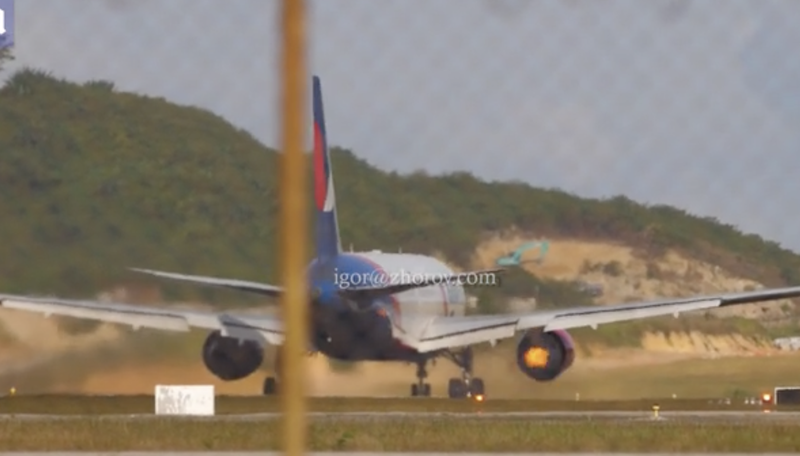Russian Jet Catches Fire Days After Planes Declared Safe Despite Sanctions

The head of Rosaviatsia, Russia’s Federal Air Transport Agency, told the country last week that foreign sanctions on plane parts entering the country had done nothing to cripple travel in and out of the country. A few days later, a Russian passenger plane carrying tourists caught fire on a tarmac in Thailand.
Azur Air, a Russia airline, was taking off from Phuket International Airport. As the plane began to speed down the runway, the 309 passengers and 12 crew members heard several loud bangs. White smoke then began pouring from one of the Boeing 767's wings. The plane seemed to have suffered a blowout due to an engine surge, as well as a malfunction in the landing gear, the Daily Mail reports. The airline gave passengers accommodations for the night and set them up with a new flight the next day.
Read more
The unusual double failure is increasing suspicion that Rosaviatsia head Alexander Neradko is using what he calls the “rearrangement” of spare parts to keep planes in service. Everyone else calls it cannibalism.
“...the rearrangement of serviceable spare parts from aircraft to aircraft was practiced always and everywhere, including during the Soviet Union,” Neradko said in an interview with Russian media outlet RBK, according to Simply Flying.
That isn’t the only practice from the Soviet days to come back to Russia. Russia has also been re-certifying old and outdated aircraft into the Russian National Register, some of which haven’t been in service since the ‘90s. At the moment, only 53 airlines from 26 countries still fly into Russia,
Russia was initially low on certified replacement parts for its leased fleet of Boeing and Airbus jets due to international sanctions against the country following the 2021 invasion of Ukraine. Neradko says that, along with cannibalising planes, the country is getting those parts from unofficial channels, which seems unlikely. Every time a passenger jet needs servicing, or a new part, vast amounts of paperwork are generated connecting that part to that plane. Without properly sourced parts and up-to-date internationally recognize service records, passenger planes can become, at best, unusable, and at worse, highly dangerous.
Experts told Wired the first thing to wear down on a plane are, predictably, the tires and the brakes but that’s not all that can break:
Worn-down tires would just be the first indication of decay. Planes are powered by computer systems that require regular maintenance, with some systems programmed to switch off after a number of flight cycles or calendar days and reset. That includes aircraft engines and auxiliary power units, the electricity generator that pumps compressed air through the cabin in flight and powers the firing of the engine when the plane is first turned on. “Some of those parts are life-limited,” says Kingsley Jones. “They literally have to be taken off the aircraft and replaced when they get to a certain age or a certain number of flights.” Despite the stereotype of running old, dilapidated planes into the ground, Russia’s fleet of aircraft compares favorably with those in much of the rest of the world. The average age of a Russian-run plane is 10.5 years, according to the Association of Tour Operators of Russia. The age of the average passenger plane worldwide is 10.3 years, according to management consultancy Oliver Wyman.
“Don’t misunderstand the Russian capability with aeronautical engineering,” says Kingsley Jones. “They are a very capable nation; they have their own aircraft manufacturing industry and are quite capable of maintaining the aircraft they do.” But as Russian airlines run down their supply of official spare parts, they’re going to be forced to adopt alternative measures. In April and May, Russian authorities widened the pool of companies that can service planes operating in the country beyond international norms. “I don’t think it’s that these aircraft are all flying deathtraps,” says Kingsley Jones. “It’s more that there’s an unknown quantity about the whole thing.” Third-party parts, produced by Russian manufacturers, could well be used to replace broken parts. This is something that happens in the rest of the world but is frowned upon by the aircraft leasing companies that provide most of the planes to carriers. (Russia has said it plans to build a parts manufacturing plant in Kazan by 2023 to fill the supply gap.) “If the situation is not really resolved in the next two or three months, Russian aircraft could be grounded totally or forced to fly with unapproved or unauthorized parts,” says Vasigh.
Neradko told RBK that spare parts are now being sourced from friendly countries — none of which build Boeing or Airbus planes. Russia was also supposed to give over 400 leased planes back to Western countries last March, but that has yet to be seen. By holding onto them, the country likely committed a $10 billion theft and because of the time sensitivity in keeping these planes up to code and in the air, has now rendered those planes useless to the original owners.
More from Jalopnik
Sign up for Jalopnik's Newsletter. For the latest news, Facebook, Twitter and Instagram.

 Yahoo Autos
Yahoo Autos 